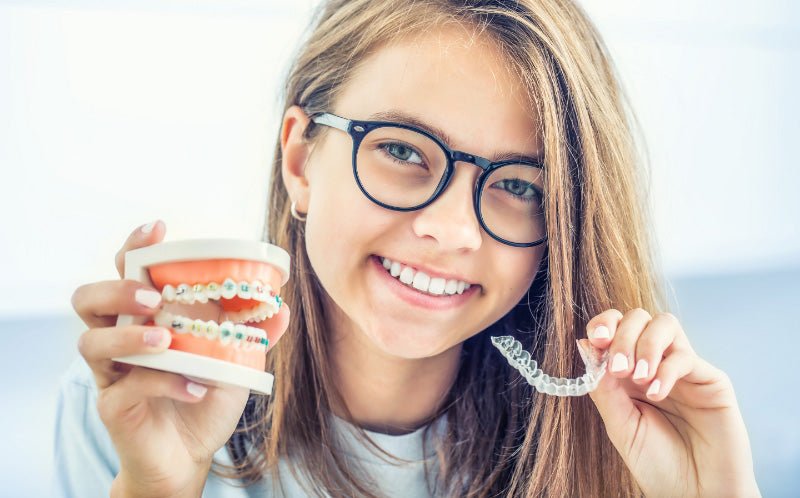Why Are My Teeth Suddenly Shifting?

When it comes to teeth, stability is critical. But if your lower or upper front teeth start to look like a cross-action toothbrush, it may be a potential orthodontic problem.
Your teeth are probably shifting!
Teeth shifting isn’t uncommon, though. It is normal, especially as we get older. And even after getting braces or other orthodontic appliances, your teeth will continue to shift slightly throughout your life.
Should you be worried about shifting teeth? Definitely!
While teeth shifting is a natural consequence of aging and chewing, it can also imply more serious dental issues such as periodontitis or gum disease.
So, if signs of teeth shifting have started to manifest and change how you eat, speak, or smile, it's time to act now.
In this article, we’ll discuss the reasons why teeth shift. We’ll also share tips to help you minimize teeth movement.
To understand these concepts better, here’s a 60-second crash course on periodontal anatomy.
What holds our teeth in the jawbone?
Many believe that gum tissue and bone are responsible for holding teeth in place, but that's not true.
Instead, there are four periodontal tissues (periodontium) that keep the tooth anchored in the jaw, and they are:
- Alveolar bone
- Periodontal ligament
- Gingiva or gums
- Cementum

The alveolar bone is a dense bone ridge that houses the tooth sockets and is situated in the jawbones that hold the teeth. The alveolar arch is the curved section of the alveolar bone that forms the jaw.
The periodontal ligament (PDL) is a soft tissue connecting the tooth and bone. The PDL attaches to the bone around a tooth and the outer root surface layer called cementum (a mineralized tissue covering the entire root surface).
The periodontal ligament is essential because it enables teeth to function correctly while chewing. The periodontal ligament also allows the tooth to adapt to the forces from habits such as bruxism or tooth grinding.
The periodontal ligament also helps maintain the health of nearby cells by transmitting nutrients through three types of blood vessels: gingival vessels, perforating vessels, and apical vessels.
On the other hand, cementum plays a vital role in maintaining the position and structural integrity of the root in the gum and bone by attaching to the collagen fibers in the periodontal ligament. Furthermore, it is intricately involved in teeth regeneration and repair mechanisms.
What do healthy periodontal tissues imply?
Healthy periodontal tissues imply that the tissues supporting the teeth function correctly and are free from disease or inflammation.
This means the teeth are stable in their position, and there are no signs of bleeding, swelling, or redness in the gums. If periodontal tissues aren’t healthy, it can lead to tooth problems, including mobility, sensitivity, and even tooth loss.
The degree of periodontal breakdown increases as we age. But the extent to which aging of periodontal tissues plays a part in this respect is yet to be defined.
What’s clear is that damage to periodontal tissues can cause significant dental health issues that can lead teeth to shift over time.
Aside from periodontal disease, human activities such as teeth grinding or bruxism, negligence (e.g., not wearing retainers after removing braces), and jawbone growth are also factors that may cause tooth movement.
Let’s discuss them one by one.

Common reasons why teeth shift
Whether it's due to the passage of time or some bad dental habits, there are a variety of reasons why teeth start to shift. Here are some of the most common culprits:
Periodontitis
As discussed earlier, an unhealthy periodontium can lead to oral health problems, causing tooth loss and teeth movement. This leads us to a commonly known disease affecting 19% of the global adult population – periodontitis.
Periodontitis, also known as gum disease, is a severe infection that affects the soft tissue surrounding our teeth. It is an infection-driven inflammatory disease often caused by dental plaque accumulation at the gingival margin.
This inflammation causes damage to the periodontal ligament, which is responsible for attaching the tooth to the alveolar bone. As a result, the ligament weakens, and the tooth loses its support, causing it to shift or become loose.
The alveolar bone supporting the teeth may also be affected, leading to bone loss and further exacerbating teeth mobility. If left untreated, periodontitis can eventually lead to tooth loss.
Although periodontitis typically affects adults, young individuals can also develop the disease and experience its harmful effects.454
Bruxism or teeth grinding
Bruxism is involuntary teeth grinding that may occur while awake or asleep. In some people, teeth grinding is a spontaneous response to anger, panic, or stress.
A study on the associations between bruxism, stress, and TMD in young students suggested that the severity of bruxism was positively correlated with the severity of TMD symptoms.
Temporomandibular disorder (TMD) affects the jaw joints and surrounding muscles and ligaments. TMD can lead to temporomandibular joint disorder or TMJ, where the muscles and ligaments around your jaw joints become inflamed or irritated.
As this dysfunction gets worse, it causes unnatural shifting in a person's mouth.
Not wearing retainers
Our teeth naturally shift throughout our life, even after orthodontic treatment. That's why dentists recommend wearing retainers after using braces or clear aligners.
Unfortunately, some patients may find wearing retainers uncomfortable or inconvenient. Therefore, some refuse to wear them for long periods.
However, skipping retainers can lead to a relapse of orthodontic issues and may require additional treatment to correct.
A good rule of thumb is to wear them every other night. But missing days or consecutive weeks can be a big deal.
A 2023 survey explored orthodontic treatment patients' compliance with wearing removable orthodontic retainers.
Based on the said survey, age and employment status were variables determining compliance. And discomfort and forgetfulness were the primary reasons for skipping retainers, besides speech difficulties.
Jawbone growth
The jawbone and teeth are connected, and changes in one can affect the other.
Similarly, jawbone growth and teeth shifting are also related because the position and development of the jawbone determine the available space for the teeth.
If the jawbone grows or develops unevenly, this can create imbalances in the spacing and alignment of the teeth, leading to crowding or gaps. These changes can significantly affect your bite.
For example, if the maxilla grows too much in the horizontal direction, it can cause an overbite, where the upper front teeth protrude excessively over the lower front teeth. This can cause difficulty in chewing and speaking, as well as aesthetic concerns.
Various factors influence jawbone growth and teeth shifting, including genetics, dental health habits, and lifestyle.
While changes in your teeth or bite may be too slight and almost unnoticeable, they shouldn’t be ignored. Some patients may require tooth extraction, dental bridge, or implants to fix their bite.

How to prevent teeth from shifting
It's essential to seek treatment if you notice any signs of teeth shifting, as early intervention can prevent further damage and address any underlying issues.
Your dentist or orthodontist can recommend treatment options based on the extent and severity of the shifting.
For example, if you’ve just had your braces removed, your orthodontist would likely recommend wearing a removable retainer.
On the other hand, your dentist might advise you to wear permanent retainers if you find it hard to adhere to the guidelines for removable retainers.
If your dentist sees signs of bruxism, they will ask you a series of questions to try and determine the underlying cause.
Addressing this issue requires revisiting your health history and checking your lifestyle, sleeping habits and stress level.
This information will help your dentist better understand your condition and develop an appropriate treatment plan.
As your overall health is revisited, you'll also have the chance to reflect on your dental hygiene. Keeping oral health in optimal shape through basic dental care practices is the simplest but most important strategy in preventing tooth shifting.
Final Thoughts
In Jenga, players take turns removing wooden blocks from a tower, trying not to make it collapse. As each block is removed, the tower becomes less stable and more likely to shift or fall.
Similarly, your teeth are like the blocks in a Jenga tower, held in place by the surrounding bone and tissue. Over time, changes in your oral health or habits, such as grinding or clenching your teeth, can cause your teeth to shift or become loose, just like the blocks in a Jenga tower.
As the teeth shift, they can create gaps, crowding, or changes in the bite, affecting the stability and function of the entire mouth.
When you receive orthodontic treatment, the orthodontist carefully positions each tooth so that it sits in the correct position and is properly supported by the surrounding teeth, gums, and bone.
After the orthodontic treatment, you need to take care of your teeth and gums to maintain good oral health and teeth stability.
This is like continuing to play Jenga, but now we must be extra careful not to accidentally bump or shake the tower, which could cause the blocks to shift or topple.
To prevent teeth from shifting, it’s essential to follow your orthodontist's advice. This means wearing retainers, maintaining good oral hygiene, avoiding hard and sticky foods, using mouthguards, and visiting your dentist regularly.
By following your orthodontist's advice, you can keep your teeth properly aligned and supported, like a stable Jenga tower, and enjoy a healthy and beautiful smile for years to come.
Get the Best Orthodontic Treatment in Culver City
Are you concerned about teeth shifting and its impact on your smile?
Look no further! At Culver City United Dental Care, we offer a range of dental procedures to help prevent and address teeth shifting.
Whether you need a retainer, orthodontic treatment, or advice on maintaining good oral hygiene, we're here to help. We also welcome patients from neighboring cities such as Marina Del Rey, Santa Monica, Inglewood, and Palms.
Don't let orthodontic problems take a toll on your confidence - schedule an appointment today to talk with an acclaimed dental professional.






